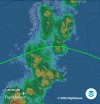I admit what I'm about to ask may make me look like a moron. That's ok. I'm good at it and my mom always told me to do what I'm good at.
I'm flying along on an IFR flight plan. There's line of weather (rain - light in some parts - heavy in others) that I need to cross. I ask for a deviation. He says deviations left and right of course approved. But then up ahead is a restricted area that he warns me about. I said I can keep deviating to the south to avoid it. He says "you can't do that, you're IFR, I have to give you vectors." So wait a second, I can make my own course to avoid weather, but I can't make my own course to avoid a restricted area?
I get that when IFR you generally do nothing but follow your flight plan or fly the vector that ATC gives you. But they allow these weather deviations. So why couldn't he allow an airspace deviation without a vector? Separation requirements? He gave me a vector and I flew on. But it got me thinking.
I'm flying along on an IFR flight plan. There's line of weather (rain - light in some parts - heavy in others) that I need to cross. I ask for a deviation. He says deviations left and right of course approved. But then up ahead is a restricted area that he warns me about. I said I can keep deviating to the south to avoid it. He says "you can't do that, you're IFR, I have to give you vectors." So wait a second, I can make my own course to avoid weather, but I can't make my own course to avoid a restricted area?
I get that when IFR you generally do nothing but follow your flight plan or fly the vector that ATC gives you. But they allow these weather deviations. So why couldn't he allow an airspace deviation without a vector? Separation requirements? He gave me a vector and I flew on. But it got me thinking.

